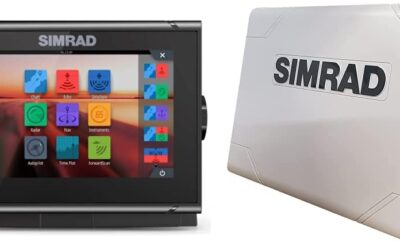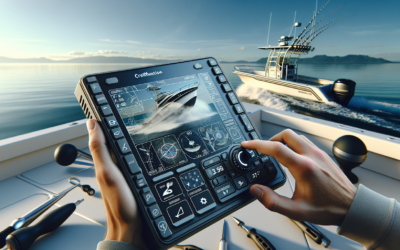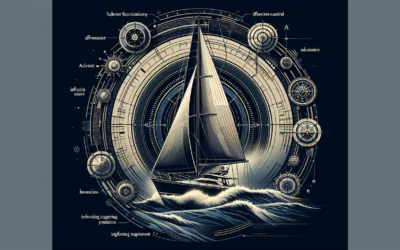In this article, you will gain a deeper understanding of Fish Finder budgeting, exploring the various price ranges available and the value they provide. Whether you’re a seasoned angler or just starting out, discovering the perfect Fish Finder within your budget can greatly enhance your fishing experience. We will guide you through the features and benefits of different price ranges, helping you make an informed decision on the ideal Fish Finder for your needs. Gone are the days of feeling overwhelmed by the vast array of options – let us simplify the process and ensure you invest in a Fish Finder that suits both your budget and fishing goals.
Part 1: Introduction to Fish Finders
What is a fish finder?
A fish finder is an electronic device used by anglers to locate fish underwater. It works by using sonar technology to send sound waves into the water. These sound waves bounce off objects such as fish and are then picked up by the fish finder, which displays them on a screen.
Importance of using a fish finder
Using a fish finder can greatly improve your fishing experience. It allows you to precisely locate fish, helping you save time and effort. By knowing where the fish are, you can increase your chances of a successful catch. Additionally, fish finders can provide valuable information about the underwater environment, such as water depth and temperature, which can further aid in your fishing strategy.
Different types of fish finders
There are several types of fish finders available on the market. The most common types include standalone fish finders, combination fish finders, and networked fish finders. Standalone fish finders are basic units that only display sonar readings. Combination fish finders, on the other hand, combine sonar with other features such as GPS and chart plotting. Lastly, networked fish finders can be connected to other devices for more advanced functionality.
Benefits of fish finders
Fish finders offer numerous benefits to anglers. They provide real-time information about the underwater environment, including depth, structure, and fish location. This information can help you determine the best spots to fish and increase your chances of success. Fish finders also save time and effort by eliminating the need to guess where fish might be hiding. Additionally, they can help you discover underwater structures that attract fish, such as drop-offs and submerged vegetation.
Factors to consider when purchasing a fish finder
Before purchasing a fish finder, there are several factors you should consider. These include the type of fishing you do, the size of your boat, your budget, and the specific features you require. It’s important to choose a fish finder that suits your needs and fishing style, as this will ensure you get the most out of your investment.
Part 2: Fish Finder Price Ranges
Understanding the different price ranges
Fish finders come in a wide range of prices, from budget-friendly options to more premium models. Understanding the different price ranges can help you determine which fish finder is within your budget and offers the features you require.
Low-priced fish finders
Low-priced fish finders are typically more basic in terms of features and functionality. They may lack advanced features such as GPS, chart plotting, and networking capabilities. However, they still provide reliable sonar readings and can be a great option for beginner anglers or those on a tight budget.
Mid-priced fish finders
Mid-priced fish finders offer a balance between affordability and advanced features. These fish finders often include GPS, chart plotting, and networking capabilities. They provide more detailed sonar readings and can be suitable for both recreational and serious anglers.
High-priced fish finders
High-priced fish finders are the most advanced and feature-rich options on the market. They offer top-of-the-line sonar technology, high-resolution displays, and advanced networking capabilities. These fish finders are typically used by professional anglers and those who want the utmost in performance and functionality.
Features and specifications at each price range
The features and specifications of fish finders vary depending on their price range. Low-priced fish finders often have smaller screens, lower resolution displays, and limited additional features. Mid-priced fish finders may have larger screens, higher resolution displays, and additional features such as GPS and chart plotting. High-priced fish finders usually have large, high-resolution screens, advanced sonar technologies, and extensive networking capabilities.
Part 3: Evaluating Value for Money
Determining the value of a fish finder
When evaluating the value of a fish finder, it’s important to consider the price in relation to the features and performance it offers. A fish finder with a higher price may offer more advanced features and better performance, but it may not always be the best value for money. It’s essential to assess the specific needs of your fishing style and determine which features are most important to you.
Analyzing the features and functionality
To determine the value of a fish finder, analyze its features and functionality. Consider whether it has the necessary sonar capabilities and if it offers additional features such as GPS, chart plotting, and networking. Assess how these features align with your fishing needs and how they contribute to the overall value of the fish finder.
Consideration of brand reputation
Brand reputation should also be taken into account when evaluating the value of a fish finder. Established and reputable brands often have a history of producing high-quality and reliable products. Researching and considering brand reputation can help ensure that you are investing in a fish finder that will perform well and last for years to come.
Reading customer reviews and ratings
Reading customer reviews and ratings can provide valuable insights into the performance and value of a fish finder. Look for reviews from anglers who have similar fishing needs and preferences as you. Pay attention to both positive and negative feedback to get a well-rounded understanding of the fish finder’s strengths and weaknesses.
Comparing prices and features
To evaluate the value for money, compare the prices and features of different fish finders within your desired price range. Consider the specific features that each fish finder offers and how they align with your fishing needs. Keep in mind that a higher-priced fish finder may not always be the best choice if it includes features that are not relevant to your fishing style.
Part 4: Low-priced Fish Finders
Overview of low-priced fish finders
Low-priced fish finders are an excellent option for anglers on a budget or beginners who are just starting their fishing journey. These fish finders provide basic sonar capabilities without the additional bells and whistles of more expensive models.
Key features of affordable options
While low-priced fish finders may be more basic, they still offer essential features such as fish detection, depth readings, and bottom structure imaging. These features can help you locate fish and identify underwater structures that attract them.
Pros and cons of low-priced fish finders
The pros of low-priced fish finders include their affordability and simplicity. They provide the basic functionality needed to locate fish and are often easy to use. However, the cons include their limited features and potentially lower performance compared to higher-priced models.
Considerations for budget-conscious buyers
Budget-conscious buyers should consider their specific fishing needs when purchasing a low-priced fish finder. If basic sonar capabilities and fish detection are the primary requirements, a low-priced option may be suitable. However, if additional features such as GPS or networking capabilities are desired, a mid-priced fish finder may be a better investment.
Recommended low-priced fish finders
Some recommended low-priced fish finders include the Garmin Striker 4, Humminbird PiranhaMAX 4, and Lowrance Hook-3x. These fish finders offer reliable sonar capabilities and basic features at an affordable price point.
Part 5: Mid-priced Fish Finders
Overview of mid-priced fish finders
Mid-priced fish finders offer a balance between affordability and advanced features. They are suitable for both recreational anglers and those seeking more functionality during their fishing adventures.
Key features of moderately priced options
Moderately priced fish finders often include features such as GPS, chart plotting, and networking capabilities. These features enhance the fishing experience by providing navigation assistance and the ability to share data with other devices.
Pros and cons of mid-priced fish finders
The pros of mid-priced fish finders include their affordability compared to higher-priced models and the additional features they offer. They provide a good balance between functionality and price. However, the cons may include slightly limited performance compared to premium options.
Factors to consider before purchasing
Before purchasing a mid-priced fish finder, consider the specific features that are important to your fishing needs. Assess the size and resolution of the screen, the type of sonar technology used, and whether additional features such as networking capabilities are necessary.
Recommended mid-priced fish finders
Some recommended mid-priced fish finders include the Garmin Striker Plus 4, Humminbird Helix 5, and Lowrance Hook Reveal 7. These fish finders offer a range of advanced features at a more affordable price than premium models.
Part 6: High-priced Fish Finders
Overview of high-priced fish finders
High-priced fish finders are designed for serious anglers and professionals who require top-of-the-line performance and functionality. They offer advanced features and cutting-edge technology to enhance the fishing experience.
Key features of premium options
Premium fish finders often include features such as high-resolution displays, advanced sonar technologies (such as CHIRP and Side Imaging), and extensive networking capabilities. These features provide detailed and accurate readings, allowing anglers to locate fish with precision.
Pros and cons of high-priced fish finders
The pros of high-priced fish finders include their superior performance, advanced features, and durability. They are designed to withstand harsh fishing conditions and provide the highest level of functionality. However, the cons include their higher price and potentially complex operation.
Factors to consider for serious anglers
Serious anglers should consider high-priced fish finders if they require the utmost performance and functionality. Advanced features such as CHIRP and Side Imaging can greatly enhance the fishing experience and help locate fish in a variety of conditions.
Recommended high-priced fish finders
Some recommended high-priced fish finders include the Garmin ECHOMAP Ultra, Humminbird HELIX 12, and Lowrance HDS LIVE. These premium fish finders offer top-of-the-line features and performance, making them suitable for serious anglers and professionals.
Part 7: Value for Money at Different Price Ranges
Getting the most value for your budget
When considering the value for money at different price ranges, it’s important to assess the specific features and performance that each fish finder offers. Determine which features are essential for your fishing needs and prioritize them when comparing fish finders within your budget.
Identifying must-have features
Identifying the must-have features for your fishing style is crucial in getting the most value for your budget. Consider whether you require advanced sonar technologies, GPS and chart plotting capabilities, networking functionalities, or additional features such as Side Imaging. Focus on the features that will contribute the most to your fishing success.
Balancing price and performance
Finding the right balance between price and performance is key to maximizing your budget. Consider whether the additional features and performance offered by a higher-priced fish finder are worth the investment for your fishing needs. Remember that a higher price does not always guarantee better performance if the features are not relevant to your style of fishing.
Comparing value across price ranges
When comparing value across different price ranges, consider the features, performance, and overall reputation of each fish finder. Look for fish finders that offer a good balance between price and performance and align closely with your fishing needs. Take into account customer reviews and ratings to gain insights into the experiences of other anglers.
Choosing the right fish finder for your needs
Ultimately, choosing the right fish finder for your needs comes down to prioritizing the features that are most important to you and aligning them with your budget. Consider your fishing style, the type of water you fish in, and the specific requirements you have. By carefully evaluating your options, you can make an informed decision and select a fish finder that provides the best value for money.
Part 8: Tips for Budgeting and Saving Money
Setting a budget for your fish finder
Setting a budget for your fish finder is an important first step in the purchasing process. Determine how much you are willing to spend and consider the features that are essential to your fishing needs. This will help narrow down your options and ensure that you stay within your budget.
Finding discounts and deals
To save money on your fish finder purchase, keep an eye out for discounts and deals. Many retailers offer promotions, especially during fishing season or holidays. Subscribe to newsletters and follow reputable fishing gear retailers to stay informed about upcoming sales and special offers.
Considering used or refurbished options
Another way to save money is by considering used or refurbished fish finders. These can often be found at a significantly lower price than brand-new models. However, ensure that you purchase from a reputable seller and thoroughly inspect the condition of the fish finder before making a purchase.
Researching and comparing prices
Researching and comparing prices is crucial in ensuring that you get the best deal for your fish finder. Take the time to visit multiple retailers and online marketplaces to compare prices. Consider the features and specifications of each fish finder and assess whether the price aligns with its value.
Making an informed purchasing decision
Before making a purchasing decision, gather all the necessary information and consider all aspects, including price, features, and customer reviews. By making an informed decision, you can confidently choose the fish finder that meets your budget and fishing needs.
Part 9: Conclusion
Recap of the importance of understanding price ranges
Understanding the price ranges of fish finders is essential in selecting a device that suits your budget and fishing needs. By knowing the different options available within each price range, you can make an informed decision and ensure that you are getting the most value for your money.
Key factors to consider when budgeting for a fish finder
When budgeting for a fish finder, it’s important to consider the features and performance that are important to your fishing style. Assess your budget and prioritize the features that will contribute the most to your fishing success. Additionally, take into account the reputation of the brand and read customer reviews to gain insights into the quality and reliability of the fish finder.
Valuable tips for maximizing your budget
To maximize your budget, consider setting a specific budget limit, looking for discounts and deals, and considering used or refurbished options. Take the time to research and compare prices, and make an informed purchasing decision based on the features, performance, and overall value of the fish finder.
Choosing the right fish finder for your fishing adventures
Choosing the right fish finder for your fishing adventures comes down to understanding your specific needs and aligning them with your budget. Consider the type of fishing you do, the size of your boat, and the features that will enhance your fishing experience. By taking all these factors into account, you can select the fish finder that will help you locate fish and make the most of your time on the water.










